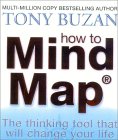 How to Mind Map: Make the Most of Your Mind and Learn How to Create, Organize, and Plan by Tony Buzan
How to Mind Map: Make the Most of Your Mind and Learn How to Create, Organize, and Plan by Tony BuzanMy rating: 4 of 5 stars
To read more reviews checkout: Reviews by Shuvam
1. Introduction:
My constant internet surfing on the topic of productivity has made me a productivity seeker. Not that I am always at peak performance, but I do not leave any chance to add any new weapon to my arsenal. However, inclement my working condition be, I am with sheer will and enough dose of motivation can help me to endure anything. On that line, I learnt about Mind Maps. While there is already a multitude of free resource available online, I feel the creator of this method, Tony Buzan, knows best about how to teach his method to others. Let’s see what we have in-store.
2. Central Theme:
Evident from the title, the book discusses the Mind Map. It is a pocket-sized reference for mind mapping. It lays down the premise of the mind map and its application in brief. For those who are not aware of Mind Mapping, it is a tool which represents information visually, usually with the aid of colours and pictures, and all the tit-bits anchors around a central theme. Below picture can better explain the idea in brief.

The Mind Map as a tool is widely used for note taking, revision tool and for brainstorming sessions. But after reading this guide I learnt various other areas where I can use Mind Maps. According to the author, the possibility of utilising Mind Map is limitless. Although, here I would differ a bit from the author as I sense that ultimately, it’s just a tool and user should use his or her discretion while making its use in day-to-day activities.
Nevertheless, I found it surprising how useful it was for me when I was planning for my Uttarkashi trip (trekking trip). I could identify all the clothing’s that I would need to carry from tip to toe.
3. Pros:
For someone, like me, who is sceptical about everything, this pocket-sized book serves as a great introduction to the topic of the Mind Map. It hardly takes two hours to finish the book, but it teaches you a valuable tool which can save you a lot of time. The technique is particularly advantageous for visual persons.
Author has done a great job in the presentation of the material. It is reader-friendly and plenty of illustrations are present. I enjoyed reading the book since it was concise and full of illustrations. Moreover, it is filled with a few workouts that will give hands-on-experience on how to use Mind Maps.
4. Cons:
The price of the book is the only downside that I feel is the con. Many avid Indian readers might not step up to buy the book when the topic can be learnt at free of cost online. Had it been produced at a special rate in India, the book might grab the attention of Indian readers.
(Price is a special consideration for me and I would be happy to talk about it in the future in a different post).
5. About the book material:
The dimension of the book:15 cm * 14 cm (length to width).
The book material is made of durable paper. Since it has used papers of higher GSM(Gram per square meter, a unit used to identify the type of paper), the book felt a bit heavy. Nevertheless, the quality of the book is and it feels great to hold it in your hand. It is ideal for library storage.
6. Conclusion:
Overall, the book is a great source to be introduced to the topic of the Mind Map. And what could be better than reading from the creator himself? Learn the secret of Mind Mapping and hopefully be relieved from the boring bulletin lists forever.
7. Information:
- Publication: Thorsons
- Year of Publication: 2002
- Author: Tony Buzan
- Number of pages: 128
- Number of Chapters: 5
- Cost of the book: ₹470
- Overall rating: 4/5





